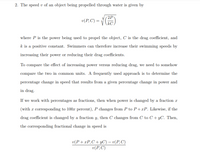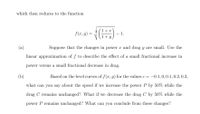
Elements Of Electromagnetics
7th Edition
ISBN: 9780190698614
Author: Sadiku, Matthew N. O.
Publisher: Oxford University Press
expand_more
expand_more
format_list_bulleted
Question
thumb_up100%

Transcribed Image Text:2. The speed v of an object being propelled through water is given by
3(2P
kC.
v(P, C) =
where P is the power being used to propel the object, C is the drag coefficient, and
k is a positive constant. Swimmers can therefore increase their swimming speeds by
increasing their power or reducing their drag coefficients.
To compare the effect of increasing power versus reducing drag, we need to somehow
compare the two in common units. A frequently used approach is to determine the
percentage change in speed that results from a given percentage change in power and
in drag.
If we work with percentages as fractions, then when power is changed by a fraction x
(with x corresponding to 100x percent), P changes from P to P+xP. Likewise, if the
drag coefficient is changed by a fraction y, then C changes from C to C + yC. Then,
the corresponding fractional change in speed is
v(P+zР,С +УС) — v(Р,С)
v(P,C)

Transcribed Image Text:which then reduces to the function
1+x
f(x, y)
1.
+ y
(a)
Suppose that the changes in power x and drag y are small. Use the
linear approximation of f to describe the effect of a small fractional increase in
power versus a small fractional decrease in drag.
(b)
Based on the level curves of f(x, y) for the values c = -0.1,0, 0.1, 0.2, 0.3,
what can you say about the speed if we increase the power P by 50% while the
drag C remains unchanged? What if we decrease the drag C by 50% while the
power P remains unchanged? What can you conclude from these changes?
Expert Solution
This question has been solved!
Explore an expertly crafted, step-by-step solution for a thorough understanding of key concepts.
This is a popular solution
Trending nowThis is a popular solution!
Step by stepSolved in 4 steps with 4 images

Knowledge Booster
Learn more about
Need a deep-dive on the concept behind this application? Look no further. Learn more about this topic, mechanical-engineering and related others by exploring similar questions and additional content below.Similar questions
- Using Epsilon and Angle of Attach to solve for the answers.arrow_forwardWhen immersed in a uniform stream V, a heavy rod hingedat A will hang at Pode’s angle θ, after an analysis by L.Pode in 1951 (Fig.). Assume that the cylinder hasnormal drag coefficient CDN and tangential coefficient CDTthat relate the drag forces to VN and VT, respectively. Derivean expression for Pode’s angle as a function of the flow androd parameters. Find θ for a steel rod, L = 40 cm, D = 1 cm,hanging in sea-level air at V =35 m/s.arrow_forwardYou are designing an airfoil for a new hobby RC plane. Because of your limited knowledge, you have mistakenly approximated your airfoil as an ellipse with a = 75mm and b = 12mm. Here, “a” is the depth of your wing and “b” is the thickness. Your plane travels through the air at approximately 20mph (8.9m/s). As it does so, skin friction produces a drag-induced heat of 800W on your wind, of length 1m. Properties of Air: k = 0.025 W/mK, Pr = 0.72, v = 1.847 x 10−5, u = 16.84 x 10−6, p = 1.2 kg/m3, B = 1/Tf (ideal gas), TInfinity = 25oC a) What is the average temperature of your wing? Assume an ellipse perimeter of approximately 200mm.arrow_forward
- An expression for the laminar velocity profile on a flat plate is u=C1sin(C2y)+C3 Where the argument of the sine function is in radians. Using the three common physicalconditions that the velocity profile should satisfy, determine d) the skin friction coefficient, Cf as a function of lengthe) displacement thickness (δ*/x) as a function of lengthf) the momentum thickness (θ/x) as a function of lengthg) the drag force (FD) on both sides of the platearrow_forwardCornering force and drag force on tires. Consider a tire that has lateral force behavior like the one in the following figure. Assuming that the drift angle is 4 degrees and the normal force F = 5000N, calculate the cornering and drag forces on the tire.arrow_forwardPls help ASAP. Pls show all work annd circle the final answer.arrow_forward
- Long flights at midlatitudes in the Northern Hemisphere encounter the jet stream, an eastward airflow that can affect a plane's speed relative to Earth's surface. If a pilot maintains a certain speed relative to the air (the plane's airspeed), the speed relative to the surface (the plane's ground speed) is more when the flight is in the direction of the jet stream and less when the flight is opposite the jet stream. Suppose a round-trip flight is scheduled between two cities separated by 3200 km, with the outgoing flight in the direction of the jet stream and the return flight opposite it. The airline computer advises an airspeed of 810 km/h, for which the difference in flight times for the outgoing and return flights is 72 min. What jet-stream speed is the computer using?arrow_forwardA prototype ship is 50 m long and designed for cruising speed of 10 m/s. The drag is to be simulated by a 1-m-long model that will be towed in a towing tank. Using Froude scaling, determine the tow speed and the ratio of the model to prototype drag and power.arrow_forwardIcebergs can be driven at substantial speeds by the wind.Let the iceberg be idealized as a large, flat cylinder, D >> L,with one-eighth of its bulk exposed, as in Fig.. Letthe seawater be at rest. If the upper and lower drag forcesdepend on relative velocities between the iceberg and thefluid, derive an approximate expression for the steady icebergspeed V when driven by wind velocity U.arrow_forward
- Darrow_forwardYou are designing an airfoil for a new hobby RC plane. Because of your limited knowledge, you have mistakenly approximated your airfoil as an ellipse with a = 75mm and b = 12mm. Here, “a” is the depth of your wing and “b” is the thickness. Your plane travels through the air at approximately 20mph (8.9m/s). As it does so, skin friction produces a drag-induced heat of 800W on your wind, of length 1m. Properties of Air: k = 0.025 W/mK, Pr = 0.72, v = 1.847 x 10−5, u = 16.84 x 10−6, p = 1.2 kg/m3, B = 1/Tf (ideal gas), TInfinity = 25oC a) What is the Reynold’s number? Hint: “D” is taken to be the thickness for an elliptical crosssection. b) What is the Nusselt number? c) What is the convection coefficient? d) What is the average temperature of your wing? Assume an ellipse perimeter of approximately 200mm.arrow_forwardPlease please correct answerarrow_forward
arrow_back_ios
SEE MORE QUESTIONS
arrow_forward_ios
Recommended textbooks for you
 Elements Of ElectromagneticsMechanical EngineeringISBN:9780190698614Author:Sadiku, Matthew N. O.Publisher:Oxford University Press
Elements Of ElectromagneticsMechanical EngineeringISBN:9780190698614Author:Sadiku, Matthew N. O.Publisher:Oxford University Press Mechanics of Materials (10th Edition)Mechanical EngineeringISBN:9780134319650Author:Russell C. HibbelerPublisher:PEARSON
Mechanics of Materials (10th Edition)Mechanical EngineeringISBN:9780134319650Author:Russell C. HibbelerPublisher:PEARSON Thermodynamics: An Engineering ApproachMechanical EngineeringISBN:9781259822674Author:Yunus A. Cengel Dr., Michael A. BolesPublisher:McGraw-Hill Education
Thermodynamics: An Engineering ApproachMechanical EngineeringISBN:9781259822674Author:Yunus A. Cengel Dr., Michael A. BolesPublisher:McGraw-Hill Education Control Systems EngineeringMechanical EngineeringISBN:9781118170519Author:Norman S. NisePublisher:WILEY
Control Systems EngineeringMechanical EngineeringISBN:9781118170519Author:Norman S. NisePublisher:WILEY Mechanics of Materials (MindTap Course List)Mechanical EngineeringISBN:9781337093347Author:Barry J. Goodno, James M. GerePublisher:Cengage Learning
Mechanics of Materials (MindTap Course List)Mechanical EngineeringISBN:9781337093347Author:Barry J. Goodno, James M. GerePublisher:Cengage Learning Engineering Mechanics: StaticsMechanical EngineeringISBN:9781118807330Author:James L. Meriam, L. G. Kraige, J. N. BoltonPublisher:WILEY
Engineering Mechanics: StaticsMechanical EngineeringISBN:9781118807330Author:James L. Meriam, L. G. Kraige, J. N. BoltonPublisher:WILEY

Elements Of Electromagnetics
Mechanical Engineering
ISBN:9780190698614
Author:Sadiku, Matthew N. O.
Publisher:Oxford University Press

Mechanics of Materials (10th Edition)
Mechanical Engineering
ISBN:9780134319650
Author:Russell C. Hibbeler
Publisher:PEARSON

Thermodynamics: An Engineering Approach
Mechanical Engineering
ISBN:9781259822674
Author:Yunus A. Cengel Dr., Michael A. Boles
Publisher:McGraw-Hill Education

Control Systems Engineering
Mechanical Engineering
ISBN:9781118170519
Author:Norman S. Nise
Publisher:WILEY

Mechanics of Materials (MindTap Course List)
Mechanical Engineering
ISBN:9781337093347
Author:Barry J. Goodno, James M. Gere
Publisher:Cengage Learning

Engineering Mechanics: Statics
Mechanical Engineering
ISBN:9781118807330
Author:James L. Meriam, L. G. Kraige, J. N. Bolton
Publisher:WILEY